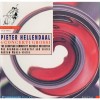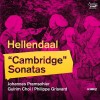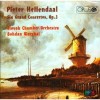Composers
Pieter Hellendaal (1 April 1721 – 19 April 1799) was an Anglo-Dutch composer, organist and violinist. He was sometimes distinguished with the suffix "The Elder", after the maturity of his musician son, Pieter Hellendaal the Younger.
At age 30, he migrated to England where he lived for the last 48 of his 78 years. He was one of the most famous composers of Dutch origin in the 18th century.
Hellendaal was born in Rotterdam on 1 April 1721, the son of Neeltje Lacroix and Johannes Hellendaal. Johannes earned a living to support his family as a candle-maker [1] while seeking paid gigs as teaching and working with amateur musicians. As a father, Johannes provided son Pieter with an intense musical education, including organ and violin. In addition to his highly creative compositions and prodigious craft as a performer, Pieter in maturity maintained himself by compositions and self-publications that respected and supported amateur musicians.
In 1731, the Hellendaal family moved to Utrecht where Pieter - still juvenile - became organist for the St. Nicholas church, (Nicolaïkerk nl:Nicolaïkerk (Utrecht), a highly visible and prestigious position: Popularly known as the "Santa Claus" Church, St. Nicholas was the second oldest parish church in the Netherlands and had been recognized for many centuries as a leader for organ music. In 1120 it was already well known as the first Dutch church to use a portable organ. The main organ in the 1730s had been built by Peter Gerritsz during the years 1477-1479, and is the first large Dutch organ and was famous as one of the first and best preserved anywhere from the Middle Ages. Under Johannes' supervision, son Pieter at age ten played the Gerritsz organ. From January 1732 (when Pieter was about twelve) until 1737 he was appointed an organist. In that year, when Pieter was 15, the Hellendaal family moved once again, this time to Amsterdam.
Soon after arrival, Pieter's outstanding talent as a violinist came to the attention of the Amsterdam city Secretary, Mattheus Lestevenon, who arranged for him (barely sixteen) to study in Italy where he stayed for six years (1737–1743). For two years of this journey (1740–1742) he studied in Padua at the Scuola delle nazioni with Giuseppe Tartini, the most famous violinist of that time.
After returning to Amsterdam in 1742, and much as his father had in his earlier years, Pieter sought an audience wherever he could, and sought paying gigs whenever possible, such as playing in the hostels of the city. Finally, two years later in 1744, he stempted to settle down by two actions that set much of the tone for the rest of his life. First, he married the daughter of a well-off Amsterdam city surgeon and started a family. Second, he obtained an official permit to start his own publishing house. Soon after permitted, he published his first two works: two sets of sonatas for violin and basso continuo. (See below under Works, Opus One and Opus Two, for fuller details.) Self-publishing his own works, including widening his market with extra directions to support performance by amateur musicians, became a hallmark of his life until his death.
To support his family despite not having found an established musical job, Pieter free-lanced, seeking gigs in The Hague and Leiden. In The Hague, the capital of the Dutch Republic, he performed regularly in the noble court of the Governor, or "Stadtholder", sometime translated as Lieutenant, an office which eventually became the Monarch. There he played for Prince William IV, and especially for the Prince's English wife, Anne of Hanover, whose enthusiasm made her known as "the musical princess". Perhaps Anne put in his mind to better his finances by moving to England where much of society was similarly enthusiastic about music, and thus there were for better prospects for a better money as a musician.
In Leiden, Pieter played the organ regularly in the Mare church, named for its location on Mare Street, a central arterial in downtown, and formerly a canal which had been paved over. Like the St Nicholas church in Utrech, it was well known as one of the first Protestant churches in Netherlands. Pieter did find a stream of paid gigs, playing for and with music enthusiasts and amateurs around the University of Leiden. For two years, 1749 until 1751, he continued his musical studies at that University.
In 1752, at age thirty, Hellendaal gave up the sporadic pay of the free-lance life, and moved his family to England where great numbers of the newly prosperous middle-class—as well as the nobility—were music enthusiast as well as amateur players, and much work was available as a teacher and performer for musicians of notable ability.
In London, Pieter soon established himself as a prominent composer and violin soloist. London newspapers during his eight years there gave conspicuous notice to his frequent performances at such then-prestigious venues as Hickford's Rooms on Brower Street, and the many other venues set up by entrepreneurs to serve the interests of the widespread musical enthusiasm of English society. His prominence gained the attention and the acquaintance of George Frideric Handel, who on 13 February 1754 helped Pieter be paid for violin solos between the acts of Acis and Galatea (HWV49a/b).
Still unable to secure a good steady job as a musician in London, Pieter, from 1760 to 1762, made his living expenses by working as the organist for St. Margaret's Church in King's Lynn, Norfolk, a port town about 97 miles north of London. Finally, a steady job! ...But not yet satisfactory to sustain his family, and not convenient for the distance from London.
When he was age forty, in 1762, Pieter moved to Cambridge, where the musical enthusiasm in academic circles around the University allowed him to settle down for the rest of his life. First, he was hired as an organist for Pembroke College, Cambridge, and was able to teach, give concerts, and compose. Fifteen years later, in 1777, he was appointed organist in the Chapel of Peterhouse where he worked until he died 37 years later in 1799, at age 78.
Recently Added
Biography
Pieter Hellendaal (1 April 1721 – 19 April 1799) was an Anglo-Dutch composer, organist and violinist. He was sometimes distinguished with the suffix "The Elder", after the maturity of his musician son, Pieter Hellendaal the Younger.
At age 30, he migrated to England where he lived for the last 48 of his 78 years. He was one of the most famous composers of Dutch origin in the 18th century.
Hellendaal was born in Rotterdam on 1 April 1721, the son of Neeltje Lacroix and Johannes Hellendaal. Johannes earned a living to support his family as a candle-maker [1] while seeking paid gigs as teaching and working with amateur musicians. As a father, Johannes provided son Pieter with an intense musical education, including organ and violin. In addition to his highly creative compositions and prodigious craft as a performer, Pieter in maturity maintained himself by compositions and self-publications that respected and supported amateur musicians.
In 1731, the Hellendaal family moved to Utrecht where Pieter - still juvenile - became organist for the St. Nicholas church, (Nicolaïkerk nl:Nicolaïkerk (Utrecht), a highly visible and prestigious position: Popularly known as the "Santa Claus" Church, St. Nicholas was the second oldest parish church in the Netherlands and had been recognized for many centuries as a leader for organ music. In 1120 it was already well known as the first Dutch church to use a portable organ. The main organ in the 1730s had been built by Peter Gerritsz during the years 1477-1479, and is the first large Dutch organ and was famous as one of the first and best preserved anywhere from the Middle Ages. Under Johannes' supervision, son Pieter at age ten played the Gerritsz organ. From January 1732 (when Pieter was about twelve) until 1737 he was appointed an organist. In that year, when Pieter was 15, the Hellendaal family moved once again, this time to Amsterdam.
Soon after arrival, Pieter's outstanding talent as a violinist came to the attention of the Amsterdam city Secretary, Mattheus Lestevenon, who arranged for him (barely sixteen) to study in Italy where he stayed for six years (1737–1743). For two years of this journey (1740–1742) he studied in Padua at the Scuola delle nazioni with Giuseppe Tartini, the most famous violinist of that time.
After returning to Amsterdam in 1742, and much as his father had in his earlier years, Pieter sought an audience wherever he could, and sought paying gigs whenever possible, such as playing in the hostels of the city. Finally, two years later in 1744, he stempted to settle down by two actions that set much of the tone for the rest of his life. First, he married the daughter of a well-off Amsterdam city surgeon and started a family. Second, he obtained an official permit to start his own publishing house. Soon after permitted, he published his first two works: two sets of sonatas for violin and basso continuo. (See below under Works, Opus One and Opus Two, for fuller details.) Self-publishing his own works, including widening his market with extra directions to support performance by amateur musicians, became a hallmark of his life until his death.
To support his family despite not having found an established musical job, Pieter free-lanced, seeking gigs in The Hague and Leiden. In The Hague, the capital of the Dutch Republic, he performed regularly in the noble court of the Governor, or "Stadtholder", sometime translated as Lieutenant, an office which eventually became the Monarch. There he played for Prince William IV, and especially for the Prince's English wife, Anne of Hanover, whose enthusiasm made her known as "the musical princess". Perhaps Anne put in his mind to better his finances by moving to England where much of society was similarly enthusiastic about music, and thus there were for better prospects for a better money as a musician.
In Leiden, Pieter played the organ regularly in the Mare church, named for its location on Mare Street, a central arterial in downtown, and formerly a canal which had been paved over. Like the St Nicholas church in Utrech, it was well known as one of the first Protestant churches in Netherlands. Pieter did find a stream of paid gigs, playing for and with music enthusiasts and amateurs around the University of Leiden. For two years, 1749 until 1751, he continued his musical studies at that University.
In 1752, at age thirty, Hellendaal gave up the sporadic pay of the free-lance life, and moved his family to England where great numbers of the newly prosperous middle-class—as well as the nobility—were music enthusiast as well as amateur players, and much work was available as a teacher and performer for musicians of notable ability.
In London, Pieter soon established himself as a prominent composer and violin soloist. London newspapers during his eight years there gave conspicuous notice to his frequent performances at such then-prestigious venues as Hickford's Rooms on Brower Street, and the many other venues set up by entrepreneurs to serve the interests of the widespread musical enthusiasm of English society. His prominence gained the attention and the acquaintance of George Frideric Handel, who on 13 February 1754 helped Pieter be paid for violin solos between the acts of Acis and Galatea (HWV49a/b).
Still unable to secure a good steady job as a musician in London, Pieter, from 1760 to 1762, made his living expenses by working as the organist for St. Margaret's Church in King's Lynn, Norfolk, a port town about 97 miles north of London. Finally, a steady job! ...But not yet satisfactory to sustain his family, and not convenient for the distance from London.
When he was age forty, in 1762, Pieter moved to Cambridge, where the musical enthusiasm in academic circles around the University allowed him to settle down for the rest of his life. First, he was hired as an organist for Pembroke College, Cambridge, and was able to teach, give concerts, and compose. Fifteen years later, in 1777, he was appointed organist in the Chapel of Peterhouse where he worked until he died 37 years later in 1799, at age 78.






![Nederlandse Komponisten uit de gouden eeuw van de Barok [CD1of2]](http://static.classicalm.com/repository/disk-cover/small/3608-img1404829922641605.jpg)